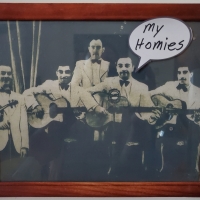DjangoBooks.com
Welcome to our Community!
Categories
- 20K All Categories
- 1.1K General
- 478 Welcome
- 59 Archtop Eddy's Corner
- 146 CD, DVD, and Concert Reviews
- 385 FAQ
- 26 Gypsy Jazz Italia
- 27 Photos
- 207 Gypsy Picking
- 21 Unaccompanied Django
- 15 Pearl Django Play-Along Vol.1
- 17 Gypsy Fire
- 45 Gypsy Rhythm
- 1.4K Gypsy Jazz University - Get Educated
- 131 Gypsy Jazz 101
- 228 Repertoire
- 224 History
- 708 Technique
- 51 Licks and Patterns
- 6 Daniel Givone Manouche Guitare Method Users Group
- 20 Eddie Lang Club
- 1.3K Gypsy Jazz Gear
- 805 Guitars, Strings, Picks, Amps, Pickups and Other Accessories
- 461 Classifieds
- 50 Recording
- 62 Other Instruments
- 18 Violin
- 5 Mandolin
- 22 Accordion
- 7 Bass
- 10 Woodwinds
- 348 Gypsy Jazz Events
- 143 North America
- 110 Europe
- 95 International










Comments
Ramirez did not do their own French polishing, it was farmed out to a specialist shop.. many of the polishers were women.
It could have been that hot-rodded shellac that European shops used up till EU air-quality legislation put an end to it.
I've repaired a few vintage/seminal instruments that had it. This modified padding shellac was basically 1# cut shellac mixed with esterified and nitrated cellulose. It also contained chemicals necessary to get everything to liquify and apply and flash-off properly when padded (ethyl acetate, butyl cellosolve, napthalene & such)
Anyway, that might explain the shellac look and the shellac claims of the maker even though the finish wore more like nitro. It might have been a cellulose modified shellac. If you've finished furniture for 25 years, you've likely encountered cellulose modified shellacs. Mohawk makes at least three hybrid formulations in various cuts, IIRC.
Pure F
Magic. A formula from Vega.
Often the base coats of shellac are sprayed on, then padded. I used a product from Behelen for years, that over a shellac wash. It applies like, looks like shellac but wears like iron, much like what was on my Ramirez.
On one of the letters back and forth from the first owner of my guitar and Ramirez leading up to the order .. contaned the phrase "goma laca".
The guitar was $400 shipped to Florida including case, imitation shark skin in grey.. Very cool. It liked Savarez including would first.
BTW my De La Chica was also FP.
My friend and neighbor is Ray Reussner, long time student and friend of Segovia, a concert guitarist and former head of the guitar dept at a prestigious university and guitar maker over the last 10 years.. now retired from all.. except concertizing on a small scale.. has a wealth of information on Ramirez guitars.. he is out of the country at the moment, I'll see what he knows about the Ramirez and finishes. He owned a few of Segovias "cast offs".
http://www.shellac.net/brush_wipe.html
A yup... :peace:
Ah mergers and acquisitions and the stack of 3-dollar MBA words used to justify them. In theory, acquisitions bring synergy, but in practice they destroy competence and put hard-won knowledge and expertise into the hands of people who neither know or care to use it.
But I digress, yes - Qualasole is about as similar as it gets today... and LacFrench & LacOver & RapidPad, (the repair versions which come in various cuts with various tpes of solvents and modifiers) Mohawk is a great finish company, and I love several of their products, but I shouldn't type that too loudly. Someone might read it and buy them to "monetize their brands" (uggh)